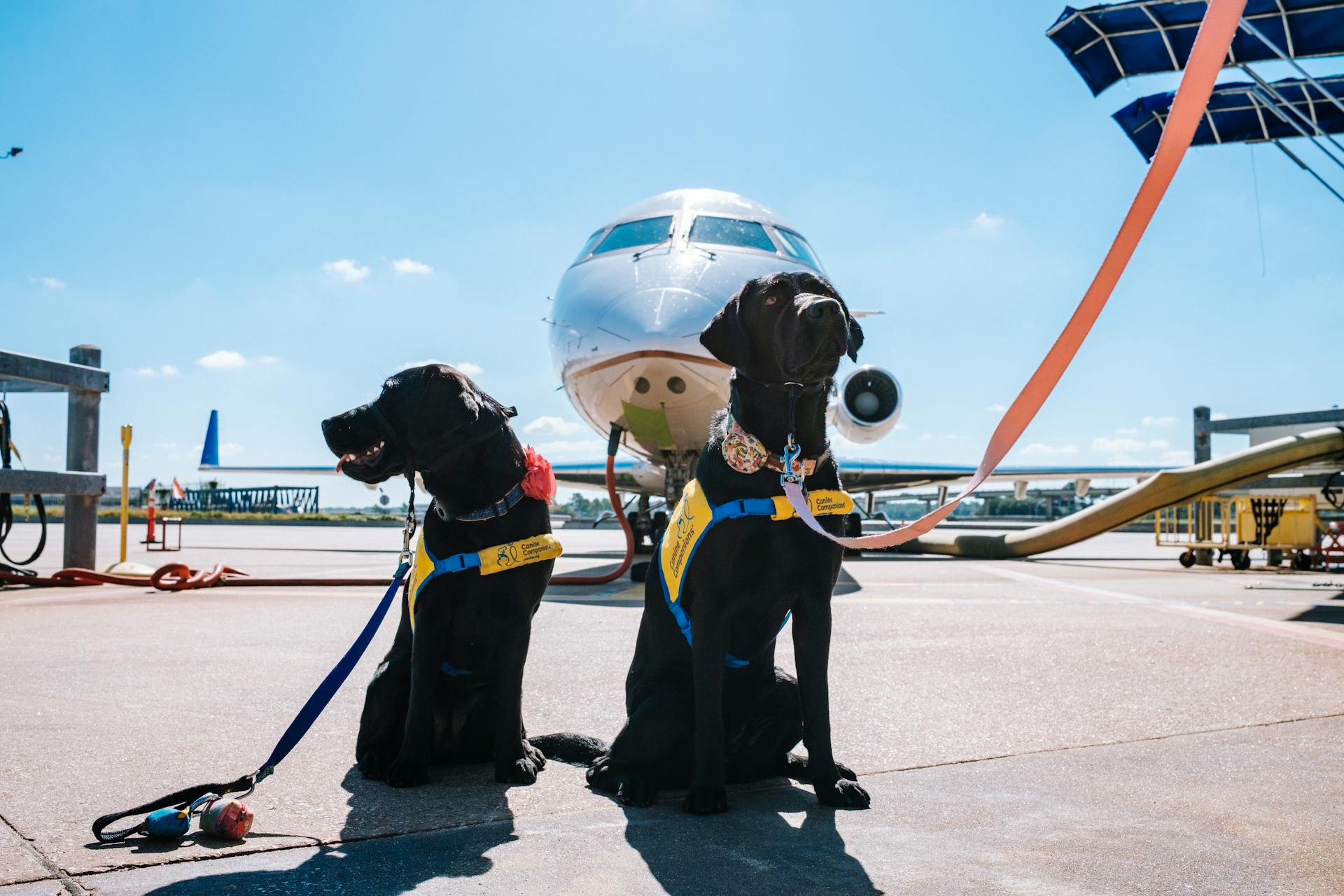
Service dogs for the blind are specially trained to assist individuals who are blind or have low vision. They can be a game-changer for everyday life.
These dogs can be trained to navigate around obstacles, stop at curbs, and even detect stairs. Their keen sense of smell and hearing helps them detect potential hazards.
For example, a service dog can be trained to stop at a curb by detecting the change in elevation. This is especially helpful when walking around unfamiliar areas.
Having a service dog by your side can greatly reduce anxiety and stress associated with navigating public spaces.
A different take: How Do Service Dogs Sense Seizures
Service Dog Organizations
If you're looking for a reputable organization that trains and places service dogs for the blind, the Guide Dog Foundation is a great place to start. They're dedicated to providing increased independence, enhanced mobility, and companionship to those in need.
Their headquarters is located at 371 East Jericho Turnpike in Smithtown, NY 11787. You can reach them by phone at 800-548-4337 or by email at [email protected].
You can also visit their website, Guide Dog Foundation For the Blind Website, to learn more about their mission and services.
Here are their contact details:
- 371 East Jericho Turnpike, Smithtown, NY 11787
- Phone: 800-548-4337
- Email: [email protected]
- Guide Dog Foundation For the Blind Website
Getting a Service Dog
To apply for a service dog, you'll need to submit an application, either online or by mail, to a guide dog school. This will ask about your finances, health, travel practices, and orientation and mobility training.
The application process typically involves a phone interview, where a representative from the school will ask about your lifestyle, health history, and finances.
A home visit is usually the next step, where a school representative will assess your home, mobility skills, and ability to care for a service dog.
You'll need to submit program fees, which can range from completely free to several hundreds or thousands of dollars. Be sure to discuss these fees with the school before signing up.
The training process typically lasts two to three weeks, where you'll live on campus and work with a school representative to match you with a dog.
Additional reading: Do Service Dogs Have to Be Registered
Understanding Guide Dogs
The Guide Dog Foundation for the Blind, Inc. trains and places guide and service dogs to provide increased independence, enhanced mobility, and companionship to people who are blind, have low vision or have other disabilities.
See what others are reading: Roselle Guide Dog

To get a service or guide dog, you'll need to have mastered mobility and orientation skills, which means being able to travel independently with a cane, cross the street, walk safely in areas familiar to you, find destinations, and have the ability to problem solve if you become lost or disoriented.
There are around fifteen different guide dog schools in the United States that will pair you with a trained dog and oversee your initial training with the dog on their campuses. You can also find multiple schools like this outside the United States.
If you're interested in getting a guide dog, you can contact the schools that interest you by calling their admissions office and asking questions about the program and the dogs they train. Questions you might want to ask include what breeds they work with, what the training process is like, and what kind of support they offer after the initial training.
You can reach out to the Guide Dog Foundation for the Blind, Inc. at 371 East Jericho Turnpike, Smithtown, NY 11787 or by calling 800-548-4337 or emailing [email protected].
You might enjoy: United States Service Dogs
Accessibility
Service dogs for the blind are trained to be incredibly attentive, with some dogs able to detect even the slightest changes in their handler's body language.
These dogs can detect changes in breathing, heart rate, and even the subtlest of sounds, allowing them to respond quickly to their handler's needs.
In fact, research has shown that service dogs can detect changes in their handler's body temperature up to 30 seconds before the handler themselves is aware of it.
This level of sensitivity is essential for service dogs to be effective, and it's a key reason why they're so valuable for people who are blind or have low vision.
Service dogs are trained to navigate through crowded spaces with ease, using their keen sense of smell and spatial awareness to avoid obstacles.
Studies have shown that service dogs can successfully navigate through spaces with as few as 10-15% of the obstacles removed, making them incredibly reliable companions.
Discover more: Blind Person and Dog
Their ability to adapt to new environments and situations is also impressive, with some dogs able to learn over 1,000 new commands in just a few months.
This level of adaptability is crucial for service dogs, as they need to be able to respond to a wide range of situations and environments.
Sources
Featured Images: pexels.com

